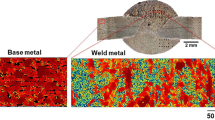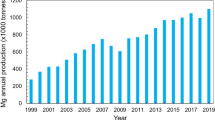Abstract
Solute and vacancy depletion have long been investigated to reveal the formation mechanism of grain boundary precipitate-free zones (GB-PFZ) during ageing, yet there is no conclusive explanation due to the simultaneous appearance of the two in GB-PFZ. In this study, the evolution of GB-PFZs and solute distributions in the vicinity of grain boundaries (GBs) were studied during the homogenisation of an Al–Cu–Mg–Mn alloy using transmission electron microscopy, high-angle annular dark field scanning transmission electron microscopy, and energy-dispersive X-ray spectroscopy. Results indicated that the evolution of GB-PFZ during homogenisation can be divided into the following three stages: Stage I, formation and recession of GB-PFZ; Stage II, absence of GB-PFZ, and Stage III, the reappearance and broadening of GB-PFZ. The results also revealed that the GB-PFZ in Stage I is totally devoid of solute depletion and its formation can be attributed to vacancy depletion alone. The GB-PFZ at Stage III solely caused by solute depletion and excludes vacancy depletion.











Similar content being viewed by others
References
Chen JH, Costan E, Huis MA, Xu Q, Zandbergen HW (2006) Atomic-pillar-based nanoprecipitates strengthen AlMgSi alloys. Science 312:416–419
Chrominski W, Lewandowska M (2016) Precipitation phenomena in ultrafine grained Al–Mg–Si alloy with heterogeneous microstructure. Acta Mater 103:547–557
Lin YC, Zhang J, Liu G, Liang Y (2015) Effects of pre-treatments on aging precipitates and corrosion resistance of a creep-aged Al–Zn–Mg–Cu alloy. Mater Des 83:866–875
Liu SD, Chen B, Li CB, Dai Y, Deng YL, Zhang XM (2015) Mechanism of low exfoliation corrosion resistance due to slow quenching in high strength aluminium alloy. Corros Sci 91:203–212
Liu H, Qiao X, Chen Z, Jiang R, Li X (2011) Effect of ultrasonic vibration during casting on microstructures and properties of 7050 aluminum alloy. J Mater Sci 46:3923–3927
Lütjering G, Albrecht J, Sauer C, Krull T (2007) The influence of soft, precipitate-free zones at grain boundaries in Ti and Al alloys on their fatigue and fracture behavior. Mater Sci Eng, A 468–470:201–209
Xu DK, Rometsch PA, Li L, Shen LM, Birbilis N (2014) Critical conditions for the occurrence of quench cracking in an Al–Zn–Mg–Cu alloy. J Mater Sci 49:4687–4697
Lin YC, Xia Y, Jiang Y, Zhou H, Li L (2013) Precipitation hardening of 2024-T3 aluminum alloy during creep aging. Mater Sci Eng, A 565:420–429
Morgeneyer TF, Starink MJ, Wang SC, Sinclair I (2008) Quench sensitivity of toughness in an Al alloy: direct observation and analysis of failure initiation at the precipitate-free zone. Acta Mater 56:2872–2884
Krol T, Baither D, Nembach E (2004) The formation of precipitate free zones along grain boundaries in a superalloy and the ensuing effects on its plastic deformation. Acta Mater 52:2095–2108
Okuda H, Ochiai S (2004) The effects of solute and vacancy depletion on the formation of precipitation-free zone in a model binary alloy examined by a Monte Carlo simulation. Mater Trans 45:1455–1460
Hirosawa S, Oguri Y, Sato T (2005) Experimental and computational investigation of formation of precipitate free zones in an Al–Cu alloy. Mater Trans 46:1230–1234
Raghavan M (1980) Microanalysis of precipitate free zones (PFZ) in Al–Zn–Mg and Cu–Ni–Nb alloys. Metall Trans A 11:993–999
Shastry CR, Judd G (1972) An electron microprobe analysis of solute segregation near grain boundaries in an Al–Zn–Mg alloy. Metall Trans 3:779–782
Ogura T, Hirosawa S, Sato T (2004) Quantitative characterization of precipitate free zones in Al–Zn–Mg(–Ag) alloys by microchemical analysis and nanoindentation measurement. Sci Technol Adv Mater 5:491–496
Hirosawa S, Sato T, Kamio A, Flower HM (2000) Classification of the role of microalloy elements in phase decomposition of Al based alloys. Acta Mater 48:1797–1806
Tolley A, Mitlin D, Radmilovic V, Dahmen U (2005) Transmission electron microscopy analysis of grain boundary precipitate-free-zones (PFZs) in an AlCuSiGe alloy. Mater Sci Eng, A 412:204–213
Okuda H, Ochiai S (2005) A Monte Carlo simulation on the PFZ microstructures in Al-based alloys during multistep annealing. Mater Sci Forum 475–479:937–940
Starink MJ, Gregson PJ (1996) S′ and δ′ phase precipitation in SiCp reinforced A1-1.2 wt%Cu -1 wt% Mg-x Li alloys. Mater Sci Eng, A 211:54–65
Starink MJ, Wang P, Sinclair I, Gregson PJ (1999) Microstrucure and strengthening of Al–Li–Cu–Mg alloys and MMCs: II. Modelling of yield strength. Acta Mater 47:3855–3868
Cai M, Robson JD, Lorimer GW (2007) Simulation and control of dispersoids and dispersoid-free zones during homogenizing an AlMgSi alloy. Scripta Mater 57:603–606
Gandin CA, Jacot A (2007) Modeling of precipitate-free zone formed upon homogenization in a multi-component alloy. Acta Mater 55:2539–2553
Chen YQ, Yi DQ, Jiang Y, Wang B, Liu HQ (2013) Concurrent formation of two different type precipitation-free zones during the initial stage of homogenization. Philos Mag 93:2269–2278
Park JK, Ardell AJ (1992) Solute-enriched surface layers and X-ray microanalysis of thin foils of a commercial aluminium alloy. J Microsc 165:301–309
Lorimer GW, Cliff G, Clark JN (1976) Developments in electron microscopy and analysis. Academic Press, London
Xie FY, Kraft T, Zuo Y, Moon CH, Chang YA (1999) Microstructure and microsegregation in Al rich Al–Cu–Mg alloys. Acta Mater 47:489–500
Norman AF, Hyde K, Costello F, Thompson S, Birley S, Prangnell PB (2003) Examination of the effect of Sc on 2000 and 7000 series aluminium alloy castings: for improvements in fusion welding. Mater Sci Eng, A 354:188–198
McPhee WAG, Schaffer GB, Drennan J (2003) The effect of iron on liquid film migration and sintering of an Al–Cu–Mg alloy. Acta Mater 51:3701–3712
Wang SB, Chen JH, Yin MJ, Liu ZR, Yuan DW, Liu JZ, Liu CH, Wu CL (2012) Double-atomic-wall-based dynamic precipitates of the early-stage S-phase in AlCuMg alloys. Acta Mater 60:6573–6580
Liu ZR, Chen JH, Wang SB, Yuan DW, Yin MJ, Wu CL (2012) The structure and the properties of S-phase in AlCuMg alloys. Acta Mater 59:7396–7405
Feng ZQ, Yang YQ, Huang B, Li MH, Chen YX, Ru JG (2014) Crystal substructures of the rotation-twinned T (Al20Cu2Mn3) phase in 2024 aluminum alloy. J Alloys Compd 583:445–451
Wang J, Zhang B, Zhou YT, Ma XL (2015) Multiple twins of a decagonal approximant embedded in S-Al2CuMg phase resulting in pitting initiation of a 2024 Al alloy. Acta Mater 82:22–31
Ogura T, Hirosawa S, Cerezo A, Sato T (2010) Atom probe tomography of nanoscale microstructures within precipitate free zones in Al–Zn–Mg(–Ag) alloys. Acta Mater 58:5714–5723
Yukawa H, Urata Y, Morinaga M, Takahashi Y, Yoshida H (1995) Heterogeneous distributions of magnesium atoms near the precipitate in Al–Mg based alloys. Acta Metal Mater 43:681–688
Hass M, Hosson JTM (2001) Grain boundary segregation and precipitation in aluminum alloys. Scripta Mater 44:281–286
Macchi CE, Somoza A, Dupasquier A, Polmear IJ (2003) Secondary precipitation in Al–Zn–Mg–(Ag) alloys. Acta Mater 51:5151–5158
Dons AL (2001) The Alstruc homogenization model for industrial aluminum alloys. J Light Met 1:133–149
Yan L, Zhang Y, Li X, Li Z, Wang F, Liu H, Xiong B (2014) Microstructural evolution of Al-0.66 Mg-0.85Si alloy during homogenization. Trans Nonferrous Met Soc China 24:939–945
Chen YQ, Yi DQ, Jiang Y, Wang B, Xu DZ, Li SC (2013) Twinning and orientation relationships of T-phase precipitates in an Al matrix. J Mater Sci 48:3225–3231
Wang SC, Starink MJ (2005) Precipitates and intermetallic phases in precipitation hardening Al–Cu–Mg–(Li) based alloys. Int Mater Rev 50:193–215
Chen YQ, Pan SP, Zhou MZ, Yi DQ, Xu DZ, Xu YF (2013) Effects of inclusions, grain boundaries and grain orientations on the fatigue crack initiation and propagation behavior of 2524-T3 Al alloy. Mater Sci Eng, A 580:150–158
Wu Y, Xiong J, Lai R, Zhang X, Guo Z (2009) The microstructure evolution of an Al–Mg–Si–Mn–Cu–Ce alloy during homogenization. J Alloys Compd 475:332–338
Lodgaard L, Ryum N (2000) Precipitation of dispersoids containing Mn and/or Cr in Al–Mg–Si alloys. Mater Sci Eng, A 283:144–152
Hirasawa H (1975) Precipitation process of Al-Mn and Al-Cr supersaturated solid solution in presence of age hardening phases. Scripta Metall 9:955–958
Liu Y, Jiang D, Xie W, Hu J, Ma B (2014) Solidification phases and their evolution during homogenization of a DC cast Al–8.35Zn–2.5 Mg–2.25Cu alloy. Mater Charact 93:173–183
Jia M, Zheng Z, Gong Z (2014) Microstructure evolution of the 1469 Al–Cu–Li–Sc alloy during homogenization. J Alloys Compd 614:131–139
Shen F, Yi D, Jiang Y, Wang B, Liu H, Tang C, Shou W (2016) Semi-quantitative evaluation of texture components and fatigue properties in 2524 T3 aluminum alloy sheets. Mater Sci Eng, A 657:15–25
Alil A, Popović M, Radetić T, Zrilić M, Romhanji E (2015) Influence of annealing temperature on the baking response and corrosion properties of an Al–4.6 wt% Mg alloy with 0.54 wt% Cu. J Alloys Compd 625:76–84
Humphreys FJ, Hatherly M (2004) Recrystallization and related annealing phenomena. Elsevier Ltd, Amsterdam
Michalcová A, Vojtĕch D, Čížek J, Procházka I, Drahokoupil J, Novák P (2011) Microstructure characterization of rapidly solidified Al–Fe–Cr–Ce alloy by positron annihilation spectroscopy. J Alloys Compd 509:3211–3218
Zeng Q, Wen X, Zhai T (2009) Effect of precipitates on the development of P orientation 011 < 566 > in a recrystallized continuous cast AA 3004 aluminum alloy after cold rolling. Metall Mater Trans A 40:2488–2497
Lucadamo G, Yang NYC, Marchi CS, Lavernia EJ (2006) Microstructure characterization in cryomilled Al 5083. Mater Sci Eng, A 430:230–241
Tsivoulas D, Robson JD (2015) Heterogeneous Zr solute segregation and Al3Zr dispersoid distributions in Al–Cu–Li alloys. Acta Mater 93:73–86
Marquis EA, Seidman DN (2001) Nanoscale structural evolution of Al3Sc precipitates in Al(Sc) alloys. Acta Mater 49:1909–1919
Robson JD, Jones MJ, Prangnell PB (2003) Extension of the N-model to predict competing homogeneous and heterogeneous precipitation in Al–Sc alloys. Acta Mater 51:1453–1468
Matsuda K, Ikeno S, Sato T, Uetani Y (2006) New quaternary grain boundary precipitate in Al–Mg–Si alloy containing silver. Scripta Mater 55:127–129
Huang YJ, Chen ZG, Zheng ZQ (2011) A conventional thermo-mechanical process of Al–Cu–Mg alloy for increasing ductility while maintaining high strength. Scripta Mater 64:382–385
Yin D, Xiao Q, Chen Y, Liu H, Yi D, Wang B, Pan S (2016) Effect of natural ageing and pre-straining on the hardening behaviour and microstructural response during artificial ageing of an Al–Mg–Si–Cu alloy. Mater Des 95:329–339
Acknowledgements
This work was supported by the National Natural Science Foundation of China (Grant Nos. 51405153 and 51475162) and by funds from the Major State Basic Research Projects of China (Grant No. 2012CB619506). We also thank Dr L.X. Wang and S.C. Li for their helpful discussion about this research.
Author information
Authors and Affiliations
Corresponding author
Rights and permissions
About this article
Cite this article
Chen, Y.Q., Pan, S.P., Tang, S.W. et al. Formation mechanisms and evolution of precipitate-free zones at grain boundaries in an Al–Cu–Mg–Mn alloy during homogenisation. J Mater Sci 51, 7780–7792 (2016). https://doi.org/10.1007/s10853-016-0062-x
Received:
Accepted:
Published:
Issue Date:
DOI: https://doi.org/10.1007/s10853-016-0062-x




